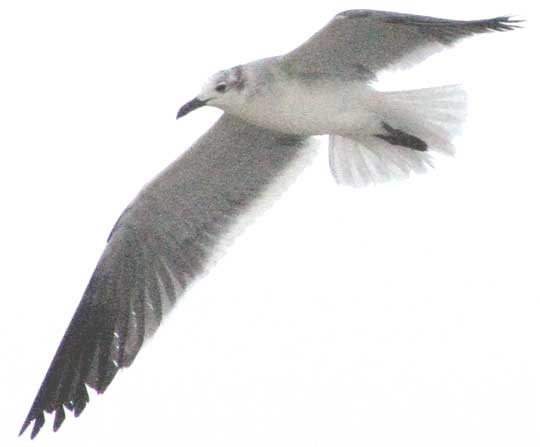Excerpts from Jim Conrad's
Naturalist Newsletter

from the May 1, 2011 Newsletter issued from Mayan Beach Garden Inn 20 kms north of Mahahual; Caribbean coastal beach and mangroves, ~N18.89°, ~W87.64°, Quintana Roo state, MÉXICO
LATE LAUGHING GULLS
Sian Ka'an's southern entrance road ends at Punta Herrero, a fishing village of about fifty, at the very tip of a long peninsula. There we found the two Laughing Gulls in their black-headed breeding plumage shown above.
In A Guide to The Birds of Mexico and Northern Central America Howell describes Laughing Gulls as winter visitors in this area from September through April. Last Tuesday was pretty late in April, so the gulls in the picture surely were just resting during their passage northward. The species overwinters as far south as northern South America, so the birds in the picture well may be part of the southernmost population, maybe fresh off the beaches of Venezuela or Columbia.
These might be the last gulls I see all summer, for no gull species regularly breeds during the summer along the Yucatan's coast. It's about the same situation with similar-looking terns -- all tern species leaving the Yucatan during the summer, though small numbers of a species or two may remain nesting in certain isolated spots, as on islands.
So, this is a curious feature of this beach during the northern summer -- the conspicuous absence of gulls and terns.
from the January 19, 2009 Newsletter issued from Mayan Beach Garden Inn 20 kms north of Mahahual; Caribbean coastal beach and mangroves, ~N18.89°, ~W87.64°, Quintana Roo state, MÉXICO
THE LAUGHING GULL'S WINTER PLUMAGE
Gulls can be hard to identify, especially in their overwintering grounds. Typically they display strikingly different immature and adult plumages, plus some species have winter plumages and even second- winter plumages. That's the case with the Laughing Gull, the Yucatán's most common gull. You can see a Laughing Gull in winter plumage below:

Theoretically you can see about eight gull species in the Yucatán, all in the genus Larus, and all only present during the winter, during migration, or "accidentally," as when deposited here by storms. Only the Laughing Gull ventures into the interior.
With all the overlapping plumages, how do I know that that's a Laughing Gull?
One good field mark is the dusky smudge behind the eye, which hints at the all-black head the gull will display during the summer. The bird's black wingtips without white "windows" plus its all-white tail and black legs support the ID. I'm not sure I could separate this from a wintering Franklin's Gull, but that species is only accidental here during migration, and migration is passed.
I love just looking at the above picture. Of course it was good seeing the bird being itself as it fished in the lagoon, but studying the pictured gull's graceful curves, its smooth transitioning of black through gray to white, the look on the bird's face... What a wonderful Universe we live in when a being as pretty as a Laughing Gull can live wild and free for everyone to see and know.
from the January 19, 2009 Newsletter issued from Hacienda San Juan near Telchac Pueblo, northwestern Yucatán, MÉXICO
LAUGHING GULLS & AN EMPTY POTATO-CHIP BAG
At this time of year the common seagull along the coast north of us is the Laughing Gull, so called because its call is slightly reminiscent of a shrill, hardy-har kind of laugh.
The most striking feature of the mature adult's appearance is its entirely black head -- as if it were wearing an executioner's hood. But that's only during the summer. They're in their winter plummage now, so of all the Laughing Gulls seen Monday, only one was mostly black, the rest having white heads with a little dark mottling. You can the species' various plummages, the species' US distribution, and read more about them at www.mbr-pwrc.usgs.gov/id/framlst/i0580id.html.
Most of Monday's gulls just flew up and down the beach, and sometimes a few birds gathered far offshore and floated in a sea of white caps. The one time the birds brought attention to themselves was when one of them plucked an empty, red potato-chip bag from the sea, and was immediately mobbed by about a dozen others.
What a racket those gulls made with their calls, and there was nothing like laughter in the sound. The birds fought for the bag, for possibly it contained a little food, as if their lives depended on it. No single bird ever kept the bag long enough to figure out whether it was empty or not.
A beach always brings into high relief the fact that most life is made possible only by the deaths of others (birds eating fish, fish eating other fish, plants and dead things, remains of dead creatures washing up on the sand...) and this fight for the red bag was a sudden, spontaneous eruption of that cold fact.
Once, a Brown Pelican crashed into the mélée, snatched up the bag, and maybe just because it was so big (90-inch wingspread) kept it long enough to see that it was empty, and dropped it back into the water. Then the fight continued among the gulls. It was still going on as we hiked up the beach, glad to forget how hunger can cause societal breakdowns in a flash.